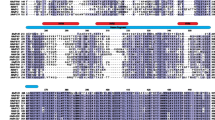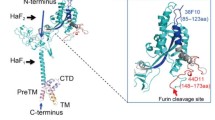Summary
We constructed and expressed different overlapping fusion proteins with the nef gene of HIV-1 and generated specific polyclonal rabbit and monoclonal mouse antibodies against these recombinant proteins. The rabbit antisera, one of the monoclonal antibodies as well as a serum from a HIV-1 infected patient recognized the nef protein with Mr 27 kDa in latently HIV-1 infected glioma cells in the immunoblot. In contrast, these antibodies could not detect nef in productively HIV-1 infected Molt-3 cells neither in immunoblot nor in indirect immunofluorescence assays. These results indicate the possible participation of nef in viral latency.
The recombinant nef proteins were used as probes for anti-nef antibodies in human sera. We observed in 17 of 57 sera tested specific anti-nef antibodies. All of these anti-nef positive sera also contained antibodies directed against viral structural proteins. The NH2-terminal region of the recombinant nef was shown to be the major immunodominant antigenic site in the immunoblot assay.
Similar content being viewed by others
References
Ahmad N, Venkatesan S (1988) Nef protein of HIV-1 is a transcriptional repressor of HIV-1 LTR. Science 241: 1481–1485
Allan JS, Coligan JE, Lee TH, McLane MF, Groopman JE, Essex M (1985) A new HTLV-III/LAV encoded antigen detected by antibodies from AIDS patients. Science 230: 810–813
Ameisen J-C, Guy B, Chamaret S, Loche M, Mouton Y, Neyrinck J-L, Khalife J, Leprevost C, Beaucaire G, Boutillon C, Gras-Masse H, Maniez M, Kieny M-P, Laustriat D, Berthier A, Mach B, Montagnier L, Lecocq J-P, Capron A (1989) Antibodies to the nef protein and to nef peptides in HIV-1-infected seronegative individuals. Aids Res Human Retrovir 5: 279–291
Appleyard RK (1954) Segregation of new lysogenic types during growth of a doubly lysogenic strain derived fromEscherichia coli K12. Genetics 39: 440–452
Arya SK (1987) 3′-orf and sor genes of human immunodeficiency virus: in vitro transcription-translation and immunoreactive domains. Proc Natl Acad Sci USA 84: 5429–5433
Arya SK, Gallo RC (1986) Three novel genes of human T-lymphotropic virus type III: immune reactivity of their products with sera from acquired immune deficiency syndrome patients. Proc Natl Acad Sci USA 83: 2209–2213
Bröker M (1986) Vectors for regulated high-level expression of proteins fused to truncated forms ofEscherichia coli β-galactosidase. Gene Anal Techn 3: 53–57
Burnette N (1981) “Western Blotting”: electrophoretic transfer of protein from sodium dodecyl sulfate-polyacrylamide gels to unmodified nitrocellulose and radiographic detection with antibody and radioiodinated protein A. Anal Biochem 112: 195–203
Chakrabarti L, Guyader M, Alizon M, Daniel MD, Desrosiers RC, Tiollais P, Sonigo P (1987) Sequence of simian immunodeficiency virus from macaque and its relationship to other human and simian retroviruses. Nature 328: 543–547
Cheng-Mayer C, Iannello P, Shaw K, Luciw PA, Levy JA (1989) Differential effects of nef on HIV replication: implications for viral pathogenesis in the host. Science 246: 1629–1632
Clavel F, Guyader M, Guetard MS, Salle M, Montagnier L, Alizon M (1986) Molecular cloning and polymorphism of the human immune deficiency virus type 2. Nature 324: 691–695
Cohen EA, Terwilliger EF, Sodroski JG, Haseltine WA (1988) Identification of a protein encoded by the vpu gene of HIV-1. Nature 334: 532–534
Fisher AG, Ratner L, Mitsuya H, Marselle LM, Harper ME, Broder S, Gallo RC, Wong-Staal F (1986) Infectious mutants of HTLV-III with changes in the 3′region and markedly reduced cytopathic effects. Science 233: 655–659
Franchini G, Robert-Guroff M, Ghrayeb J, Chang NT, Wong-Staal F (1986) Cytoplasmic localization of the HTLV-III 3′ orf protein in cultured T cells. Virology 155: 593–599
Gallo RC, Wong-Staal F, Montagnier L, Haseltine W, Yoshida M (1988) HIV/HTLV gene nomenclature. Nature 333: 504
Gombert FO, Blecha W, Tähtinen M, Ranki A, Pfeifer S, Tröger W, Braun R, Müller-Lantzsch N, Jung G, Rübsamen-Waigmann H, Krohn K (1990) Antigenic epitopes of NEF proteins from different HIV-1 strains as recognized by sera from patients with manifest and latent infection. Virology 176: 458–466
Guy B, Kieny MP, Riviere Y, Le Peuch C, Dott K, Girad M, Montagnier L, Lecocq JP (1987) HIV F/3′ orf encodes a phosphorylated GTP-binding protein resembling an oncogene product. Nature 330: 266–269
Hammes SR, Dixon EP, Malim MH, Cullen BR, Greene WC (1989) Nef protein of human immunodeficiency virus type 1: evidence against its role as a transcriptional inhibitor. Proc Natl Acad Sci USA 86: 9549–9553
Harlow E, Lane D (1988) Antibodies. A laboratory manual. Cold Spring Harbor Laboratory, New York
Haseltine WA (1989) Silent HIV infections. New Engl J Med 320: 1487–1489
Kim S, Ikeuchi K, Byrn R, Groopman J, Baltimore D (1989) Lack of a negative influence on viral growth by the nef gene of human immunodeficiency virus type 1. Proc Natl Acad Sci USA 86: 9544–9548
Koenen M, Rüther U, Müller-Hill B (1982) Immunoenzymatic detection of expressed gene fragments cloned in the LacZ gene ofE. coli. EMBO J 1: 509–512
Laemmli UK (1970) Cleavage of structural proteins during assembly of the head of bacteriophage T4. Nature 227: 680–685
Lowry OH, Rosebrough NJ, Farr AL, Randall RJ (1951) Protein measurement with the Folin phenol reagent. J Biol Chem 193: 265–275
Luciw PA, Cheng-Mayer C, Levy JA (1987) Mutational analysis of the human immunodeficiency virus: The orf-B region down-regulates virus replication. Proc Natl Acad Sci USA 84: 1434–1438
Mellert W, Festl H, Kleinschmidt A, Müller-Lantzsch N, Erfle V (1989) Cell-specific control of HIV production in chronically infected glial cells. In: Fifth international conference on AIDS, abstract no W.C.P.91
Müller-Lantzsch N, Fan H (1976) Monospecific immunoprecipitation of murine leukemia virus polyribosomes: identification of p30 protein-specific messenger RNA. Cell 9: 579–588
Müller-Lantzsch N, Lenoir GM, Sauter M, Takaki K, Bechet J-M, Kuklik-Ross C, Wunderlich D, Bornkamm GW (1985) Identification of the coding region for a second Epstein-Barr virus nuclear antigen (EBNA-2) by transfection of cloned DNA fragments. EMBO J 4: 1805–1811
Niederman TMJ, Thielan BJ, Ratner L (1989) Human immunodeficiency virus type 1 negative factor is a transcriptional silencer. Proc Natl Acad Sci USA 86: 1128–1132
Popovic M, Read-Connole E, Gallo RC (1984) T4 positive human neoplastic cell lines susceptible to and permissive for HTLV-III. Lancet ii: 1472–1473
Ranki A, Krohn M, Allain JP, Franchini G, Valle SL, Antonen J, Leuther M, Krohn K (1987) Long latency precedes overt seroconversion in sexually transmitted human-immunodeficiency-virus infection. Lancet ii: 589–593
Ratner L, Haseltine W, Patarca R, Livak KJ, Starcich B, Josephs SF, Doran ER, Rafalski Ja, Whitehozn EA, Baumeister K, Ivanoff L, Petteway SR, Pearson ML, Lautenberger JA, Papas TS, Ghrayeb J, Chang NT, Gallo RC, Wong-Staal F (1985) Complete nucleotide sequence of the AIDS virus, HTLV-III. Nature 313: 277–284
Ratner L, Starcich B, Josephs SF, Hahn BH, Reddy EP, Livak KJ, Petteway SR, Pearson ML, Haseltine WA, Arya SK, Wong-Staal F (1985) Polymorphism of the 3′ open reading frame of the virus associated with the acquired immune deficiency syndrome, human T-lymphotropic virus type III. Nucleic Acids Res 13: 8219–8229
Reiss P, de Ronde A, Lange JMA, de Wolf F, Dekker J, Debouck C, Goudsmit J (1989) Antibody response to the viral negative factor (nef) in HIV-1 infection: a correlate of levels of HIV-1 expression. AIDS 3: 227–233
Riviere Y, Tanneau-Salvadori F, Regnault A, Lopez O, Sansonetti P, Guy B, Kieny M-P, Fournel J-J, Montagnier L (1989) Human immunodeficiency virus-specific cytotoxic response of seropositive individuals: distinct types of effector cells mediate killing of targets expressing gag and env proteins. J Virol 63: 2270–2277
Sabatier J-M, Clerget-Raslain B, Fontan G, Fenouillet E, Rochat H, Granier C, Gluckman J-C, Rietschoten JV, Montagnier L, Bahraoui (1989) Use of synthetic peptides for the detection of antibodies against the nef regulating protein in sera of HIV-infected patients. AIDS 3: 215–220
Samuel KP, Seth A, Konopka A, Lautenberger JA, Papas Ts (1987) The 3′ orf protein of human immunodeficiency virus shows structural homolgy with the phosphorylation domain of human interleukin-2 receptor and the ATP-binding site of the protein kinase family. FEBS Lett 218: 81–86
Sanger F, Nicklen S, Coulson AR (1977) DNA sequencing with chain-terminating inhibitors. Proc Natl Acad Sci USA 74: 5463–5467
Sauter M, Müller-Lantzsch N (1987) Characterization of an Epstein-Barr virus nuclear antigen 2 variant (EBNA 2B) by specific sera. Virus Res 8: 141–152
Spindler K, Rosser D, Berk A (1984) Analysis of adenovirus transforming proteins from early regions 1A and 1B with antisera to inducible fusion antigens produced inEscherichia coli. J Virol 49: 132–141
Terwilliger E, Sodrosky J, Rosen CA, Haseltine WA (1986) Effects of mutations within the 3′ orf open reading frame region of human T-cell lymphotropic virus type III (HTLVIII/LAV) on replication and cytopathogenicity. J Virol 60: 754–760
Wain-Hobson S, Sonigo P, Danos O, Cole S, Alizon M (1985) Nucleotide sequence of the AIDS virus, LAV. Cell 40: 9–17
Walter G, Scheidtmann K-H, Carbone A, Laudono AP, Doolitle RF (1980) Antibodies specific for the carboxy- and aminoterminal regions of simian virus 40 large tumor antigen. Proc Natl Acad Sci USA 77: 5197–5200
Author information
Authors and Affiliations
Rights and permissions
About this article
Cite this article
Kienzle, N., Bröker, M., Harthus, H.P. et al. Immunological study of the nef protein from HIV-1 by polyclonal and monoclonal antibodies. Archives of Virology 118, 29–41 (1991). https://doi.org/10.1007/BF01311301
Received:
Accepted:
Issue Date:
DOI: https://doi.org/10.1007/BF01311301




